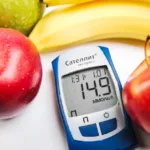Classification of diabetes, including screening and diagnosis of prediabetes and rare variants of diabetes, has been discussed in the ADA standards of care section 2 [Ref].
Generally, Diabetes is classified into the following four types:
Classification of Diabetes | |
| Type 1 Diabetes | Characterized by:
Caused by: Includes: |
| Type 2 Diabetes | Characterized by:
Caused by: Includes: |
| Specific Types | Characterized by:
Includes:
|
| Gestational Diabetes | Characterized by:
Caused by: Includes: |
Type 1 diabetes is further divided into three different stages based on symptoms, blood glucose, and autoimmunity.
The following table summarizes the three different stages of Type 1 Diabetes Mellitus:
Stages of Type 1 Diabetes | |||
| Stage 1 | Stage 2 | Stage 3 | |
| Characteristics | Autoimmunity | Autoimmunity | Autoimmunity |
| Normoglycemia | Dysglycemia | Overt hyperglycemia | |
| Presymptomatic | Presymptomatic | Symptomatic | |
| Diagnostic Criteria | Multiple Islet autoantibodies | Islet antibodies | Autoantibodies may become absent |
| No IGT or IFG | Dysglycemia: IFG and/ or IGT
| Diabetes by standard criteria | |
Criteria for the diagnosis of diabetes mellitus:
The three commonly used tests to diagnose diabetes mellitus are A1C, fasting blood glucose, and post-prandial blood glucose.
The criteria for the diagnosis of diabetes are summarized in the table below:
Criteria for the diagnosis of Diabetes | |
| FPG (fasting plasma glucose) | 126 or more (7 mmol/L or more) after no caloric intake for at least 8 hours. |
| 2-hour post-prandial glucose | 200 mg/dl or more (11.1 mmol/L or more) during OGTT. The test is performed as recommended by the WHO following a 75 gm of anhydrous glucose. |
| A1C | 6.5% or more (48 mmol/mol). The test should be performed in standardized laboratories. |
In addition, for individuals with a hyperglycemic crisis or those who are markedly symptomatic, a single random blood glucose of 200 mg/dl (11.1 mmol/L) or more is diagnostic of Diabetes Mellitus.
Type 1 Diabetes Mellitus: ADA 2023 Recommendations:
Type 1 Diabetes Screening:
Screening for Type 1 Diabetes mellitus is only recommended for research purposes and may be considered in an individual with a first-degree relative with Type 1 Diabetes Mellitus.
Screening tests for Type 1 Diabetes Mellitus include autoantibodies to:
- Insulin
- Glutamic acid decarboxylase (GAD)
- Islet antigen 2
- Zinc transporter 8
The development of multiple antibodies that persist may necessitate labeling the patient as stage 2 type 1 diabetes. Such patients may be enrolled in clinical trials for appropriate intervention.
Type 2 Diabetes Mellitus and Prediabetes: ADA 2023 Recommendations:
Risk assessment tool:
Screening for prediabetes or diabetes may be performed with an informal assessment of risk factors or a validated risk calculator.
Screening for Diabetes in Obese Individuals:
All adults who are overweight or obese (BMI of 25 kg/m² or more or 23 kg/m² or more for Asians) and have one or more risk factors for diabetes should undergo a screening test for diabetes or prediabetes.
Screening for Diabetes in Adults, regardless of body weight:
Screening for diabetes or prediabetes should begin at the age of 35 for all adults, irrespective of body weight or risk factors.
Repeat testing if initial screening tests are normal:
Repeat screening tests for diabetes or prediabetes are recommended every three years after age 35 in asymptomatic individuals. The tests may be done earlier in individuals who become symptomatic or who develop risk factors such as a change in body weight.
Which screening tests are appropriate to diagnose Diabetes or Prediabetes?
Fasting Plasma Glucose, 2-hour post-prandial blood glucose using a 75 gm oral glucose tolerance test, or A1C from a standard laboratory are all considered appropriate screening tests.
When performing an oral glucose tolerance test, taking at least 150 g of glucose for three days is recommended before performing the 75 g oral glucose tolerance test.
In addition, for individuals with diabetes or prediabetes, cardiovascular risk factors should be identified and treated.
Should children be screened for Diabetes or Prediabetes?
Children may be screened at the onset of puberty or after the age of 10 years if they are overweight (BMI of 85th percentile or more) or obese (BMI of 95th percentile or more) and have one or more risk factors for diabetes.
Screening for Diabetes in people with HIV infection:
A fasting plasma glucose is recommended for all HIV-infected patients as a screening test for diabetes and prediabetes:
- Before treatment with antiretroviral therapy is initiated
- After 3 – 6 months of antiretroviral therapy
- At the time of switching to antiretroviral therapy
If initial screening tests are normal, repeat screening with plasma glucose is recommended yearly.
Criteria for screening for Diabetes and prediabetes in asymptomatic adults |
1. Testing should be considered for overweight or obese individuals (BMI of 25 kg/m2 or more or a BMI of 23 kg/m2 or more for Asians) with at least one or more of the following risk factors:
|
| 2. People with prediabetes should be tested yearly |
| 3. People with GDM should be screened for diabetes every three years for life |
| 4. For all individuals other than those mentioned above should be screened at the age of 35 years |
| 5. Individuals with normal results should be screened every three years. Frequent testing may be done if a person develops risk factors or symptoms. |
| 6. People with HIV |
Do we need to screen children and adolescents for Type 2 Diabetes?
Risk-based screening for Type 2 Diabetes or Prediabetes in asymptomatic children and adolescents is recommended in the following settings:
Screening should be considered at puberty or after the age of 10 in overweight (BMI equal to or more than the 85th Percentile) or obese (BMI equal to or more than the 95th Percentile) children with at least one of the following:
- Maternal history of diabetes or GDM during the child’s gestation
- Family history of diabetes in the first or second-degree relative
- High ethnic group
- Signs of insulin resistance or conditions associated with insulin resistance, such as acanthosis nigricans, PCOS, dyslipidemia, or small for gestational age birth weight
ADA Diagnostic Criteria for Prediabetes:
Prediabetes is diagnosed based on the following tests:
Criteria Defining Prediabetes | |
| Fasting Plasma Glucose | 100 – 125 mg/dl (5.6 – 6.9 mmol/l) |
| 2-hour plasma glucose during 75 gm OGTT | 140 – 199 mg/dl (7.8 – 11 mmol/L) |
| A1C | 5.7 – 6.4% (39 – 47 mmol/mol) |
Screening for rare types of diabetes:
Cystic fibrosis-related diabetes:
- Begin testing for cystic fibrosis-related diabetes at the age of 10 with an oral glucose tolerance test
- A1C is not recommended for diagnosing cystic fibrosis-related diabetes
- Treat cystic fibrosis-related diabetes with insulin to achieve glycemic targets
- Annual monitoring for complications associated with diabetes is recommended 5 years after the diagnosis of cystic fibrosis-related diabetes.
Post-transplant Diabetes:
- Screening for hyperglycemia is recommended after an organ transplant, however, a formal diagnosis of post-transplant diabetes is made once the infection has settled and the patient is on stable immunosuppressive therapy.
- 75 gm OGTT is the recommended screening test to diagnose post-transplant diabetes.
- Choose the best immunosuppressive drugs to minimize transplant rejection regardless of the risks of developing diabetes.
Monogenic Diabetes Syndromes:
- Genetic testing is recommended for neonatal diabetes
- Genetic testing for maturity-onset diabetes of the young should be performed in patients who do not fit into either type 1 or type 2 diabetes mellitus and have a family history of diabetes in at least two successive generations (suggestive of autosomal dominant inheritance)
Gestational Diabetes mellitus: ADA 2023 recommendations:
Screening for diabetes is recommended for all individuals with risk factors who are planning to conceive.
Screening for diabetes should be considered for all individuals of childbearing age for undiagnosed diabetes.
Before the 15th week of gestation, screening is recommended for all individuals with risk factors. Screening should be considered for individuals without risk factors at the first prenatal visit using a standard diagnostic test if screening has not been done earlier.
Individuals of childbearing age diagnosed to have diabetes should be treated.
Use FBS or A1C to screen for early abnormal glucose metabolism:
- Fasting glucose of 110–125 mg/dL (6.1 mmol/L) or
- A1C 5.9–6.4% (41–47 mmol/mol).
Screen for GDM at 24–28 weeks of gestation in pregnant women who have not been diagnosed to have diabetes or have a high-risk abnormal glucose metabolism detected early in pregnancy.
Screen individuals with GDM for prediabetes or diabetes at 4 to 12 weeks after delivery, using the 75 g OGTT and clinically appropriate nonpregnancy diagnostic criteria.
Individuals with a history of GDM should have lifelong screening for the development of diabetes or prediabetes at least every 3 years.
Individuals with a history of GDM found to have prediabetes should receive intensive lifestyle interventions and/ or metformin to prevent diabetes.
Screening and Diagnosis of GDM:
OGTT is performed to screen for and diagnose GDM. It is performed following the WHO criteria as tabulated below:
One-step OGTT |
| Perform a 75 g OGTT at 24–28 weeks of gestation in individuals not previously diagnosed with diabetes. Measure plasma glucose when the patient is fasting, at 1 hour and at 2 hours. |
| The OGTT should be performed in the morning after an overnight fast of at least 8 hours. |
The diagnosis of GDM is made when any of the following plasma glucose values are met or exceeded:
|
Two-step OGTT |
| Step 1: Perform a 50 g non-fasting GLT (Glucose load test), with plasma glucose measurement at 1 h, at 24 to 28 weeks of gestation in individuals not previously diagnosed with diabetes. |
| If the plasma glucose level measured at 1 hour after the load is ≥130, 135, or 140 mg/dL (7.2, 7.5, or 7.8 mmol/L, respectively), proceed to a 100-g OGTT. |
| Step 2: The 100-g OGTT should be performed when the patient is fasting. |
The diagnosis of GDM is made when at least two of the following four plasma glucose levels (measured fasting and at 1, 2, and 3 h during OGTT) are met or exceeded:
|
- Premium Ingredients: Our tea blend features high-quality Berberine, aromatic Oolong, and refreshing Mint, all organicall…
- Mint Flavored: Enjoy the cool, crisp taste of mint that perfectly complements the robust flavors of Berberine and Oolong…
- Unsweetened with Zero Calories: Crafted for those who appreciate the natural flavors of tea, our blend is completely uns…
- Special firm control midsection shapewear bodysuit:Waist trainer bodysuit use special craftsmanship around the middle pa…
- Super comfortable shapewear tummy control:The tummy control body shaper is 360° seamless well-made,made of top grade pol…
- Fits everything in your wardrobe:This seamless bodysuit tank top can be an outwear directly,prefect match with jeans,pan…

- Great stretchy fabric: 90% Nylon, 10% Spandex.Super soft and stretchy.Package content:3* Bodysuit.
- Sexy Tank Top Bodysuits, flattering square neckline with tapered shoulder straps,simple in design,don’t see through, Bes…
- Knit Ribbed Seamless Design,gives you maximum freedom of movement. High elasticity and snap-button fastening at the bott…

- LOOK FANTASTIC & CHARMING: Fajas Colombian bodysuit shapewear is designed to specially shape the midsection with targete…
- FIRM CONTROL & COMPRESSION: Fajas bodysuit trims the waist, compresses the belly, and lifts the butt, and the Outer with…
- NON-SLIP SHOULDER STRAP: These faja bodysuit Straps are fully adjustable and non-slip in design. The Open Bust design al…









